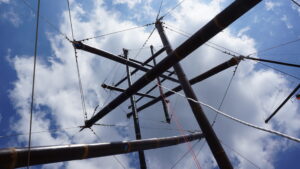Week 9 – Rehearsal with audience and performance
- by Marie
- in research fascia
- posted July 21, 2021
This section serves to create the connective tissues between the audience and the performance/research project.
Please feel free to leave your comments at the bottom of this page.
Hereunder is a brief of the piece given out to the audience on the performance day
Striking chords
Striking chords intends to weave the fabric between the poetic, the somatic and the performative by exploring the physiological properties of the connective tissues and what Dr Stephen M Levin calls ‘the new biomechanics’.
This group research focuses on fascial awareness and biotensegrity in dance via touch and non-touch practices inspired by Contact Improvisation and experiential anatomy. In particular, we attend to the body and inter-bodies’ relationships as living architectures following the laws of tensegrity structures, such as seeing the body and the composition of bodies in space as compression elements floating in continuous tension.
As well as re-creating a fascial matrix amongst the dancers, we develop a non-touch practice experiencing the eyes as a fascial organ, a voluminous mass, a skin organ that can act as an interface between our ‘innersphere’ (Joanne Avison) and our ‘kinesphere’.
By pursuing this research I propose to use the tensegrity system as a model to apprehend the relational realm and to shift the relationships’ dynamic within a group. Through redefining our understanding of biomechanics as a holistic interdependent system able to adapt and differentiate depending on its use, we redefine and question our position in the world, our roles and identities amongst a group of individuals.
Choreographer/researcher: Marie Chabert
Performers/researchers: Josephine Dyer, Olivia Walton, Maya Takeda, Helena Clark, Tara Pollitt, Jan-Ming Lee, Zoë Solomons, Pete Guy Spencer (online research)
Composer: Michael Picknett
Special Thanks: Many thanks to the dancers/researchers for their great contribution. Thanks to Mike for stepping in, and to Henrietta for her support. Thanks to the project Bunny Rabbit for letting us play and help building their tensegrity structure ‘All along the watchtower’.


Recent Comments